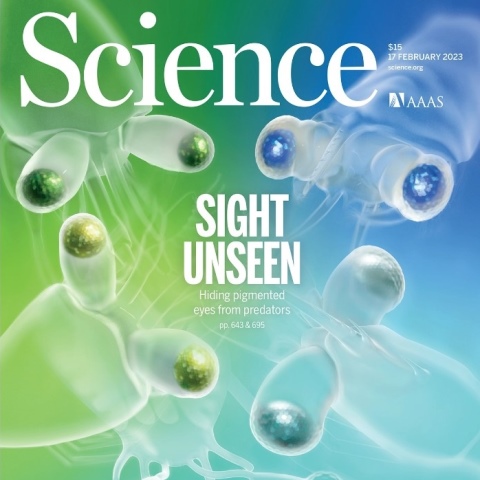How did a Welshman end up studying crustaceans in the middle of the Negev desert? Funny you should ask…
Dr. Ben Palmer is a member of BGU's chemistry department. He is fascinated by the crystals that help crustaceans and fish see. His latest research about the camouflage capabilities of larval shrimp has now made
the cover of
Science:

The cover of the latest issue of
Science | Photo Credit:
Science
"Larval crustaceans are born in the sea and then float with the current. Their only form of protection is that they are transparent. However, there is one part of their body that they cannot make transparent- their eyes. To see, they need dark eye pigments, which expose them to predators. To circumvent this issue, they build a complex optical shield around each eye. The amazing thing about it? The shield reflects light that matches the shade of the water they inhabit. It ranges from deep blue to yellow depending on the water," explains Dr. Palmer.
While discovering new aspects of the animal world fills Dr. Palmer with joy, there are practical future applications of his findings if they can be understood well enough.
The findings – which reveal a particularly compact and tunable photonic glass in the “eye glitter” structures of these animals – could be used to inspire the design of various materials. “By mimicking nature’s solutions, humans can optimize and develop better photonic materials for solar energy, commu¬nications, remote sensing, and other light-dependent technologies,” write Kate Feller and Megan Porter in a
related Perspective.
The shrimp | Photo Credit: Ben Palmer/BGU
To better understand it, Dr. Palmer and his student Keshet Shavit and colleagues used optical and cryogenic scanning electron microscopy to investigate the eyeshine reflector in several larval crustaceans, including Machrobrachium rosenbergi, a model species of freshwater prawn.
A new cryo-sem microscope was just donated to the University by Nahum Guzik. That microscope and the short drive to Eilat, which has an amazing biodiversity, makes Ben-Gurion University ideal for Dr. Palmer's work, and so the Welshman happily stays on in the desert.
Palmer and his students and colleagues found that the eyeshine is produced by highly reflective cells made from a photonic glass comprised of crystalline isoxanthopterin nanospheres, which reside on the interior surface of the eye.
“A distinguishing feature of the eyeshine reflector described here is its tunability and compactness,” say the authors. Further investigation across different larval crustacean species showed that their eyeshine color is modulated – from deep blue to yellow – by tuning the size and order of the nanospheres.
“The diversity of optical solutions discovered in just a few recently investigated pelagic crustaceans spotlights the untapped potential for photonic innovation yet to be found in animals living in the open ocean,” write Feller and Porter, discussing the broader research field. They say such exciting photonic discoveries are only being made now because “the vastness of the pelagic realm, and the relatively sparse distribution of animals within it, makes this habitat difficult to access and sample effectively.”
Additional researchers include Avital Wagner, and Gan Zhang (Ph.D. student and postdoc in the Palmer lab), Dr. Lukas Schertel of the University of Cambridge, Dr. Viviana Farstey of The Interuniversity Institute for Marine Sciences in Eilat, Dr. Derya Akkaynak of the University of Haifa, BGU's Dr. Alexander Upcher, BGU's Prof. Amir Sagi, Dr. Venkata Jayasurya Yallapragada of the Indian Institute of Technology, and Dr. Johannes Haataja of the University of Cambridge.
The research was supported by ERC Starting Grant (grant 852948, “CRYSTALEYES”); Dr. Palmer is the Nahum Guzik Presidential Recruit and a recipient of the 2019 Azrieli Faculty Fellowship. This work was also supported by the European Union’s Horizon 2020 research and innovation program under the Marie Skłodowska-Curie grant agreement (893136) and a Swiss National Science Foundation Grant (grant 40B1-0_198708). Electron microscopy studies were supported by the Ilse Katz Institute for Nanoscale Science & Technology at Ben-Gurion University.